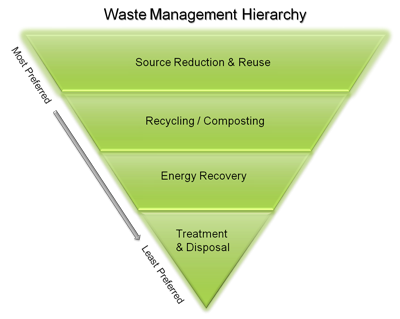Preventing Trash at the Source
Learn More
Marine debris is often the result of poorly-managed waste on land. Between 1960 and 2013, the average amount of trash generated by each person in the U.S. nearly doubled from 2.68 to 4.40 pounds per day. As litter, this waste can end up in waterways and flow downstream into the oceans, where it becomes marine debris.
The most effective way to prevent marine and aquatic debris is to prevent waste in the first place. This is known as source reduction, or pollution prevention. We can reduce waste by considering packaging when buying anything, and we can reuse materials like containers and products. We can also use reusable items. For example, bring your own silverware and cup to work, rather than use disposables that are tossed every day. Lastly, we can recycle almost anything from plastics to electronics, depending on local recycling capabilities.
 These principles are in EPA’s Waste Management Hierarchy, which ranks waste management strategies from best to least effective. Source reduction is even better. The Pollution Prevention Act (1990) calls for source reduction practices to prevent hazardous substances, pollutants, or contaminants from being released into the environment. These practices include equipment or technology modifications, process changes, reformulation or redesign of products, substitution of raw materials, and improvements in housekeeping, maintenance, training, or inventory control.
These principles are in EPA’s Waste Management Hierarchy, which ranks waste management strategies from best to least effective. Source reduction is even better. The Pollution Prevention Act (1990) calls for source reduction practices to prevent hazardous substances, pollutants, or contaminants from being released into the environment. These practices include equipment or technology modifications, process changes, reformulation or redesign of products, substitution of raw materials, and improvements in housekeeping, maintenance, training, or inventory control.
Source reduction conserves resources and energy, usually costs less, and reduces marine debris.
What Can You Do?
Anyone, from a student to a CEO, can prevent waste from ending up in our oceans. Find out more about What You Can Do to protect water at home and in your community.
Did You Know?
- Americans generated about 254 million tons of waste in 2013. Only about a third of this -- 34.3% -- was recycled or composted.
- Promoting reusable water bottles and installing hydration stations, or water fountains, prevents marine debris and also prevents GHG emissions and saves money.
- Sometimes natural events like hurricanes can cause marine debris. Find out more about EPA disaster debris removal.
Packaging
In most parts of the developed world, packaging constitutes as much as one-third of the non-industrial solid waste stream. As the developing world races to raise living standards, these countries are also seeing more packaging waste. At least 28 countries currently have laws designed to reduce packaging and promote greater recycling of it. Many countries require manufacturers to take back packaging discards or pay for their recycling.
There are no federal packaging mandates in the United States. However, some state and local governments have taken action. For example, many cities in California have banned single-use plastic bags. Meanwhile, new containers and packaging materials have added complications to recycling. New ways to increase the recovery of packaging materials and plastics are clearly needed.
- Eliminating toxic constituents
- Using less material
- Making packaging more reusable
- Using more recycled content
- Making it more readily recyclable
Some states, localities and groups are taking steps to reduce, reuse and recycle more packaging discards. Here are some examples:
State of California – Manufacturers Challenge to reduce packaging discards 50% by 2020
The California Department of Resources Recycling and Recovery (CalRecycle) is investigating ways to reduce packaging as part of a comprehensive set of strategies to reach the statewide goal Exit of eliminating, recycling, or composting 75% of solid waste by 2020. One of these efforts, CalRecycle’s Manufacturers Challenge, Exit challenges packaging manufacturers and brand owners to reduce packaging waste 50% by 2020, particularly for the paper and plastic packaging identified as priorities in CalRecycle’s November 2014 Packaging workshop. Exit
